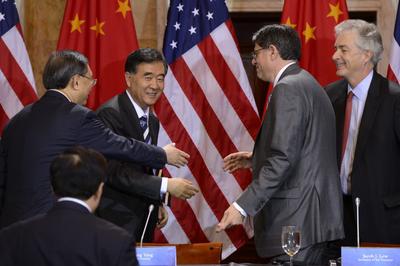The fifth S&ED held on 10–11 July was an opportune occasion for both sides to follow up on the broad ‘consensus’ reached by both leaders during their informal meeting in California in June, and to more substantively discuss the core issues confronting the world’s two largest economies.
This year’s talks encompassed discussions on cyber security — a positive development signalling that emerging areas of contention can be quickly brought into existing bilateral channels. And for the first time in such talks, the sensitive topic of missile defence was raised. In many respects, the S&ED epitomises the growing institutionalisation of the relationship between Washington and Beijing.
This institutionalisation is also seen in an increasing range of dialogue mechanisms and arrangements complementing the S&ED, including over a dozen regular sub-dialogues on regional and global issues of bilateral concern, the many working groups of the US–China Joint Commission on Commerce and Trade, and the consultative talks on defence and defence policy. Regular engagement between both governments now span across more than 50 dialogues, forums and working groups. Last year, then US Secretary of State Hillary Clinton asserted that both powers ‘literally consult with each other almost on a daily basis about every consequential issue’ confronting them and the world.
Critics argue that US–China architectures such as the S&ED are nothing more than glorified talk-shops. They argue that these mechanisms have thus far failed to produce any real progress in cooperation and have little to show other than general statements and pledges. They point to growing Chinese assertiveness, China’s military expansion and opacity, as well as perceived ‘irresponsible’ behaviour in cyber security, maritime security and international trade, as evidence that such talks have accomplished little in influencing Beijing.
Idealists on the other hand see US–China summitry as forming the basis of a new ‘Group of Two’ or a budding great power concert, one around which a potentially more beneficent global order is being shaped and pursued. The term ‘Chimerica’ is emblematic of such an impression.
But both critics and idealists do not fully appreciate the complexity and nuances of the US–China relationship. Dialogue mechanisms, even one as comprehensive and high-level as the S&ED, are not diplomatic cure-alls that will easily eliminate the challenges facing the Sino–American relationship. The nature of the US–China relationship is such that it will always be characterised by a degree of friction — not least because of differences in national systems and political values — and no amount of sophisticated diplomacy will be able to easily remove these differences.
What then is the utility of these dialogue mechanisms? For a start, they act as information-sharing sessions that may help reduce uncertainty and manage expectations. They also help facilitate circumstances under which reciprocity and collaboration may more easily occur. As Robert Keohane mused: ‘In order to cooperate in world politics on more than a sporadic basis, human beings have to use institutions’. This is especially applicable to the US–China relationship, where a considerable trust deficit exists.
But perhaps the most useful thing about these mechanisms is that they help create a certain baseline of predictability and structure to the tricky US–China relationship. The relative permanence and regularity of these channels offer a degree of assurance that diplomatic relations will not be allowed to regress beyond a certain point. Certainly, the hope is that regular, face-to-face meetings will help Chinese and American decision-makers forge closer personal relations that will eventually translate into a mutually profitable working relationship.
Seen in such a context, mechanisms like the S&ED are not as unproductive as some would suggest. In 2012, the fourth S&ED produced some 50 tangible outcomes even as the Chen Guangcheng embassy incident threatened to overshadow the event. And at this year’s S&ED, the Snowden affair did not prevent both sides from reaching a ‘significant breakthrough’ in agreeing to begin negotiations on an unprecedented bilateral investment treaty.
The Obama administration clearly considers US–China dialogue structures as useful platforms for managing bilateral relations and, increasingly, for coordinating responses on a range of regional and global issues. For the Chinese, many view such dialogues as indicating that the prevailing hegemon, the United States, is increasingly willing to engage a rising China on an equal footing.
Both sides of course still have a long way to go in terms of converging expectations of each other’s conduct. But short of concrete alternatives, sustained institutionalised bilateral engagement is perhaps the best way for navigating the trials and tribulations of the US–China relationship.
Hoo Tiang Boon is a Research Fellow with the China Programme at the S. Rajaratnam School of International Studies, Nanyang Technological University in Singapore.
A version of this article was published here as RSIS Commentary No. 137/2013.

